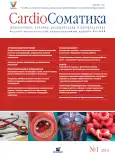Exercise training and endothelial dysfunction
- Authors: Pomeshkina S.A1
-
Affiliations:
- Research Institute for Complex Problems of cardiovascular diseases, Kemerovo
- Issue: Vol 5, No 1 (2014)
- Pages: 63-66
- Section: Articles
- URL: https://journals.rcsi.science/2221-7185/article/view/45091
- DOI: https://doi.org/10.26442/CS45091
- ID: 45091
Cite item
Full Text
Abstract
Full Text
##article.viewOnOriginalSite##About the authors
S. A Pomeshkina
Research Institute for Complex Problems of cardiovascular diseases, Kemerovo
Email: рomesa@cardio.kem.ru
канд. мед. наук, зав. лаб. реабилитации
References
- Mudau M, Genis A, Lochner A, Strijdom H. Endothelial dysfunction: the early predictor of atherosclerosis. Cardiovasc J Afr 2012; 23 (4): 222-31.
- Whelton S.P, Chin A, Xin X, He J. Effect of aerobic exercise on blood pressure: a meta - analysis of randomized, controlled trials. Ann Intern Med 2002; 136: 493-503.
- Mora S, Lee I.M, Buring J.E, Ridker P.M. Association of physical activity and body mass index with novel and traditional cardiovascular biomarkers in women. JAMA 2006; 295: 1412-9.
- Gayda M, Brun C, Juneau M et al. Long - term cardiac rehabilitation and exercise training programs improve metabolic parameters in metabolic syndrome patients with and without coronary heart disease. Nutr Metab Cardiovasc Dis 2008; 18 (2): 142-51.
- Tambalis K, Panagiotakos D.B, Kavouras S.A, Sidossis L.S. Responses of blood lipids to aerobic, resistance, and combined aerobic with resistance exercise training: a systematic review of current evidence. Angiology 2009; 60 (5): 614-32.
- Wang J.S. Exercise and thrombogenesis. J Biomed Sci 2006; 13: 753-61.
- Evrengul H, Seleci D, Tanriverdi H, Kaftan A. The antiarrhythmic effect and clinical consequences of ischemic preconditioning. Coron Artery Dis 2006; 17: 283-8.
- Taylor R.S, Brown A, Ebrahim S et al. Exercise - based rehabilitation for patients with coronary heart disease: systematic review and meta - analysis of randomized trials. Am J Med 2004; 116: 682-97.
- Mc Allister R.M, Laughlin M.H. Vascular nitric oxide: effects of physical activity, importance for health. Essays Biochem 2006; 42: 119-31.
- Griffin K.L, Woodman C.R, Price E.M et al. Endothelium - mediated relaxation of porcine collateral - dependent arterioles is improved by exercise training. Circulation 2001; 104 (12): 1393-8.
- Sessa W.C, Pritchard K, Seyedi N et al. Chronic exercise in dogs increases coronary vascular nitric oxide production and endothelial cell nitric oxide synthase gene expression. Circ Res 1994; 74: 349-53.
- Goto C, Nishioka K, Umemura T et al. Acute moderate - intensity exercise induces vasodilation through an increase in nitric oxide bioavailiability in humans. Am J Hypertens 2007; 20 (8): 825-30.
- Higashi Y, Sasaki S, Kurisu S et al. Regular aerobic exercise augments endothelium - dependent vascular relaxation in normotensive as well as hypertensive subjects: role of endothelium - derived nitric oxide. Circulation 1999; 100: 1194-202.
- Uematsu M, Ohara Y, Navas J.P et al. Regulation of endothelial cell nitric oxide synthase mRNA expression by shear stress. Am J Physiol 1995; 269: C1371-C1378.
- Hudlicka O, Brown M, Egginton S. Angiogenesis in skeletal and cardiac muscle. Physiol Rev 1992; 72: 369-417.
- Lloyd P.G, Prior B.M, Yang H.T, Terjung R..L. Angiogenic growth factor expression in rat skeletal muscle in response to exercise training. Am J Physiol Heart Circ Physiol 2003; 284: H1668-H1678.
- Gavin T.P, Robinson C.B, Yeager R.C et al. Angiogenesis growth factor response to acute systemic exercise in human skeletal muscle. J Appl Physiol 2003; 96: 19-24.
- Fontana J, Fulton D, Chen Y et al. Domain mapping studies reveal that the M domain of hsp90 serves as a molecular scaffold to regulate Aktdependent phosphorylation of endothelial nitric oxide synthase and NO release. Circ Res 2002; 90: 866-73.
- Olfert I.M, Breen E.C, Mathieu-Costello O, Wagner P.D. Skeletal muscle capillarity and angiogenic mRNA levels after exercise training in normoxia and chronic hypoxia. J Appl Physiol 2001; 91: 1176-84.
- Lönna M.E, Dennis J.M, Stocker R. Actions of «antioxidants» in the protection against atherosclerosis. Free Radic Biol Med 2012; 53 (4): 863-84.
- Davis M.E, Cai H, Mc Cann L et al. Role of c-Src in regulation of endothelial nitric oxide synthase expression during exercise training.Am J Physiol Heart Circ Physiol 2003; 284: H1449-H1453.
- Matsumoto A, Hirata Y, Momomura S et al. Increased nitric oxide production during exercise. Lancet 1994; 343: 849-50.
- Rush J.W, Turk J.R, Laughlin M.H. Exercise training regulates SOD-1 and oxidative stress in porcine aortic endothelium. Am J Physiol Heart Circ Physiol 2003; 284: H1378-H1387.
- Higashi Y, Sasaki S, Nakagawa K et al. Endothelial function and oxidative stress in renovascular hypertension. N Engl J Med 2002; 346: 1954-62.
- Van Guilder G.P, Westby C.M, Greiner J.J et al. Endothelin-1 vasoconstrictor tone increases with age in healthy men but can be reduced by regular aerobic exercise. Hypertension 2007; 50 (2): 403-9.
- Maeda S, Miyauchi T, Kakiyama T et al. Effects of exercise training of 8 weeks and detraining on plasma levels of endothelium - derived factors, endothelin-1 and nitric oxide, in healthy young humans. Life Sci 2001; 69: 1005-16.
- Lavrencic A, Salobir B.G, Keber I. Physical training improves flowmediated dilation in patients with the polymetabolic syndrome. Arterioscler Thromb Vasc Bio 2000; 20: 551-5.
- Griffin K.L, Laughlin M.H, Parker J.L. Exercise training improves endothelium - mediated vasorelaxation after chronic coronary occlusion. J Appl Physiol 1999; 87: 1948-56.
- Yen M.H, Tang J.H, Sheu J.R et al. Chronic exercise enhances endothelium - mediated dilation in spontaneously hypertensive rats. Life Sci 1995; 57: 2205-13.
- Willson J.R, Kapoor S.C. Contribution of prostaglandins to exercise - induced vasodilation in humans. Am J Physiol 1993; 265: H171-H175.
Supplementary files







